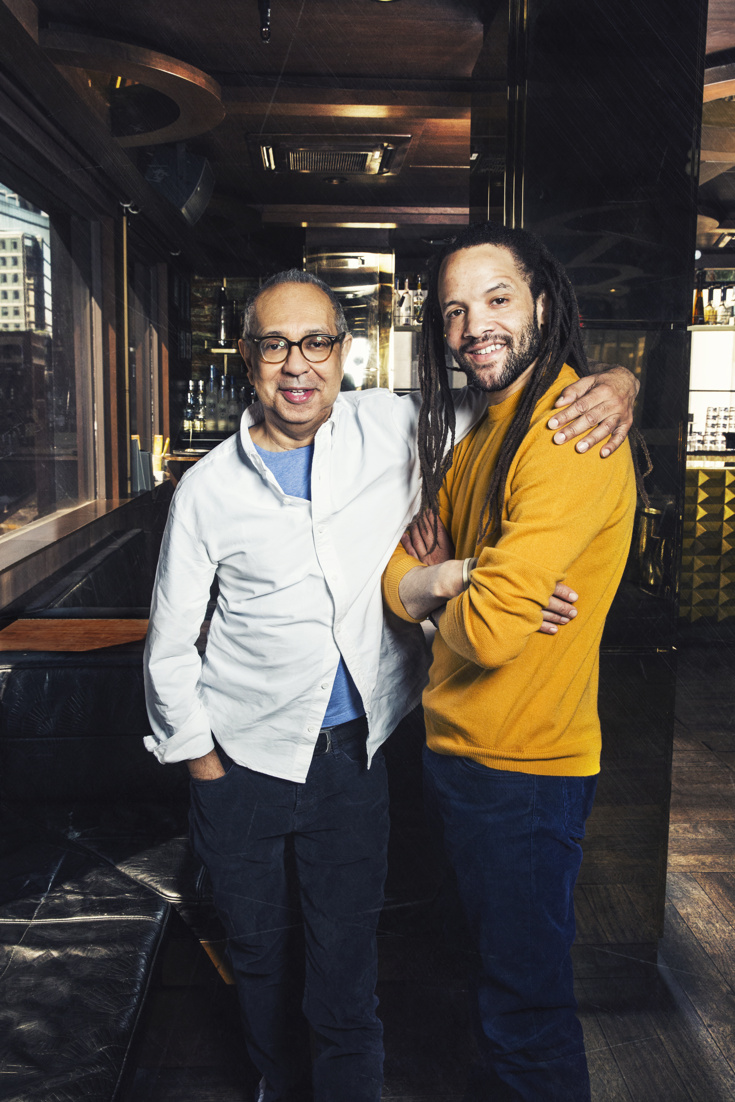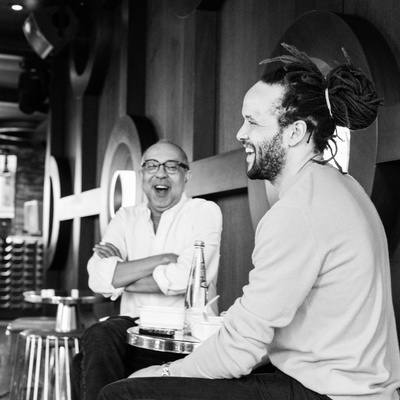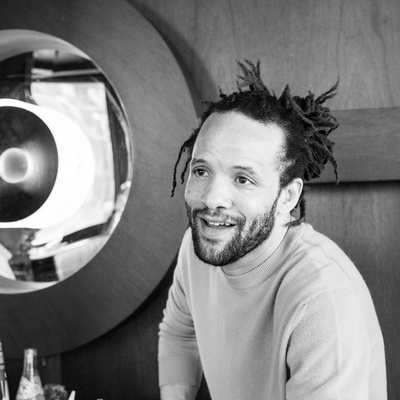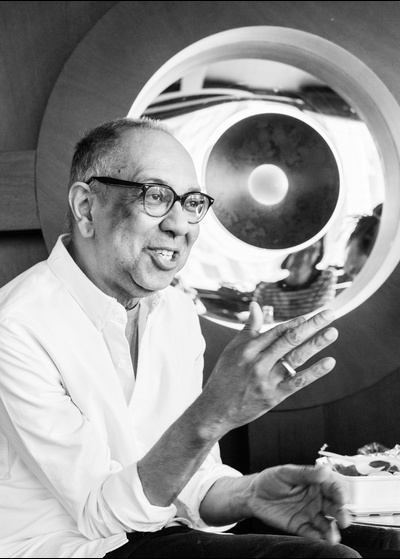Shuffle Along Dream Team George C. Wolfe & Savion Glover on Collaborating Again, Capturing the Spirit of the ‘20s & Not Seeing Hamilton

(Photo: Caitlin McNaney)
With a trio of Tony winners and a pair of Tony nominees above the title, Shuffle Along boasts the Broadway season’s starriest lineup. But two of the show’s most celebrated names never appear on stage. The director and book writer of this jazzy “musical sensation” is George C. Wolfe, whose productions of Jelly’s Last Jam, Angels in America, Caroline, or Change and The Normal Heart, among many others, secured his spot as one of the theater’s all-time greats. Adding to the excitement is the Broadway return of the brilliant choreographer Savion Glover, whose partnership with Wolfe on Bring in ’Da Noise, Bring in ’Da Funk earned Tonys for both men. That was 20 years ago, but Wolfe and Glover remain a dream team, and just before opening night, they shared a teasing banter as they discussed their past, present and future collaborations—including why Savion is not in the cast of Shuffle Along.
Q: Seeing the two of you sitting here feels like Broadway history coming to life. What do you love about working together?
SAVION: For me, it’s just being around George. Although I am choreographing, every opportunity to be in his presence is a learning opportunity. I like learning, and who better to learn from than someone as handsome as this man!
GEORGE: The main thing I love about Savion is that he is not “precious” about the work. The worst thing when you’re working is to say, “I have a question,” and the other person goes, “No! This is what it is.” That kind of rigidity is very challenging because musicals are constantly mutating. I can throw something at him, and he’ll say, “OK, what about this?” That level of generosity ends up living in the material, and the audience picks up on the spirit in which the show was created. It takes an incredibly evolved skill set to be as flexible as Savion.

Q: You’ve known each other for almost 25 years—since Savion played the younger version of Jelly Roll Morton in Jelly’s Last Jam.
GEORGE: He wasn’t that young! He just ages well. He’s really 79. He’s older than me.
SAVION: I think our relationship has matured over the years. I can relate to him now as a grown man, versus a youngster.
GEORGE: How old were you in Jelly?
SAVION: I was finishing high school. I remember turning 21 on the tour. That was a great birthday.
Q: Savion is known for his dynamic, athletic style of tapping. What was it like creating dances set to 1920s jazz?
SAVION: Well, I love period music. We aren’t creating anything new here; it’s some of the same moves we’ve seen in the past, but with my energy—it’s a ‘20s feel with a twist of today’s energy.
GEORGE: That’s 100 percent wrong. What he’s doing is new. It’s completely and totally new, in the same way that Shuffle Along was new and startling in 1921. White downtown Broadway had never seen a show like this. They’d never seen dancing or heard music like this, not just jazz but syncopation. His choreography has the spirit of the ‘20s and also the spirit of something raw and contemporary because the rhythm is continuous.
Q: What’s it like to choreograph for stars who haven’t been known for their dancing, like Audra McDonald and Brian Stokes Mitchell?
SAVION: Very satisfying. I remember going into the room and saying, “OK, we’re going to do this, and I can give you the simplified version.” They always said, “No, give us the hard version. Give us the real deal.” They all stepped up.
GEORGE: They would say [in the beginning], “I don’t know what the hell I’m doing now, but come March, I will.”
SAVION: And they did. They would try certain things one week, and two or three weeks later, the choreography would be embodied through the acting and everything else. It was a lot of fun for me.
Q: Let’s address an obvious question: Savion, did you ever consider appearing in Shuffle Along?
SAVION: Yes, I did.
Q: Why did you decide not to?
GEORGE: Because someone said, “You’re not going to be in the show.” And that was me.
SAVION: In the beginning, I thought I was going to be in the show. After maybe our third meeting, I realized…
GEORGE: …I said it in the first meeting because I know you.
SAVION: He may have said it, but I didn’t hear it.
GEORGE: It’s a monster, monster show! Let me ask you a question. Could you have been in it? In previews?
SAVION: Choreographed it and been in it? Probably not.
GEORGE: Thank you!
SAVION: I know two spots. I could do the William Still role, and I could do the Baby C role [musical numbers featuring ensemble dancers Phillip Attmore and Curtis Holland].
GEORGE: At some point, one of those dancers is going to be tied up in the closet and Savion is going to walk onstage and do the number. That will happen.
SAVION: We just don’t know when.

Q: How about a revival of Jelly’s Last Jam, starring Savion in the role created by Gregory Hines?
SAVION: Yes, that’s on my palette.
GEORGE: He’s working on that, too, and I have to direct it. He should do Jelly. Definitely, without question. That one, you could choreograph and be in it.
SAVION: Yeah, because I can do improvisation with the solo stuff.
Q: Savion, you haven’t worked on Broadway in 20 years. Did you consciously step away?
SAVION: I’ve had requests to do things over the years, but I don’t want to be the Cat in the Hat in Seussical. I create dance projects and continue to bring awareness to the dance until something worth my integrity comes about.
Q: You must have had other opportunities to choreograph on Broadway.
SAVION: No, I didn’t, actually. I just was developing my own productions and tours.
Q: You also run a dance school in Newark. Why is teaching important to you?
SAVION: That’s who I am. My mother always taught us that the more you know, the more you should share. It’s in the building where I first studied—when it was Newark Community School of the Arts. One day a friend said, “This building is for sale,” and we bought it. when it was Newark Community School of the Arts. One day a friend said, “This building is for sale,” and we bought it.
GEORGE: I didn’t know you had gone there as a kid. Wow, that’s wonderful.

Q: George, it’s been 12 years since you directed Caroline, or Change on Broadway. Have you missed musicals?
GEORGE: What’s that Larry Gelbart line? “Wherever Hitler is, I hope he’s out of town with a musical.” I absolutely love working on musicals, but anytime I finish a project I want to move on to something completely different. When I did Lucky Guy, Nora Ephron’s play, I thought, “I miss that seedy, dangerous world of New York in the ‘80s. Let me go live there.” What is the exact opposite of that? A 1921 New York musical. I’ve been thinking about Shuffle Along off and on for a period of time, and then some part of me said, “The time for this is now."
Q: This has been a busy season for musicals. Has either of you seen Hamilton?
SAVION: I have not.
GEORGE: No.
Q: Are you interested in seeing it?
GEORGE: Yeah! But we’ve been in an intense cave [of preparation] since last summer, and once I start to immerse yourself in this world, I can’t watch any bad TV, I can’t read books, I can’t see anything that’s going to take me out of it. I adjust my rhythms and don’t let anything contaminate it. Now that we’re opening, I will be able to see musicals.

Q: What do you hope audiences will take away from Shuffle Along? And now that it’s done, what do you love most about it?
GEORGE: At the end of the day, Shuffle Along is about people coming together and making something extraordinary—and history not necessarily being kind to them. It’s about the love of necessarily being kind to them. It’s about the love of doing, regardless of the consequences. And ultimately, it’s about something we all care about, which is, “Will I be remembered for what I did?” Everybody wants to be remembered for the best of who they are.
SAVION: I love everything about this show. My favorite piece is “Struttin’,” which was my first opportunity to choreograph something that has nothing to do with tap dancing. George pushed me, and I accepted the challenge. I’m just overwhelmingly happy and proud to be part of this project.
